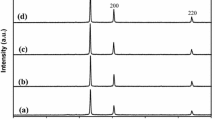Abstract
Synthesis of hydrophilic copper nanoparticles with an additional coating of an hydrophilic polymer has been carried out by use of hydrazine hydrate (HH) and sodium formaldehyde sulfoxylate (SFS) in aqueous medium. The effect of temperature on nanoparticles when synthesized in aqueous medium has been studied. It is observed that an ideal temperature ranges some where between 70 and 80 °C. Nearly phase-pure nanocopper can be obtained when both sodium succinate and polyvinyl alcohol (PVA) are used together to provide double capping in aqueous medium. It is observed that the surface plasmon resonance (SPR) phenomena is sensitive to experimental conditions and handling of the nanoparticles. X-ray diffraction measurements (XRD) revealed a broad pattern for the fcc crystal structure of copper metal. The particle diameter by use of Scherrer’s equation was calculated to be about 43 nm. Thermal analysis (TGA) revealed ~10–60% weight loss due to the presence of surfactants. Scanning electron microscopy (SEM) and transmission electron microscopy (TEM) showed that there is clustering of spherical particles in dry state.







Similar content being viewed by others
References
Arul Dhas N, Raj CP, Gedanken A (1998) Synthesis, characterization and properties of metallic copper nanoparticles. Chem Mater 10:1446–1452
Chen S, Sommers JM (2001) Alkanethiolate-protected copper nanoparticles: spectroscopy, electrochemistry, and solid-state morphological evolution. J Phys Chem B 105:8816–8820
Cioffi N, Torsi L, Ditaranto N, Sabbatini L, Zambonin PG, Tantillo G, Ghibelli L, D’Alessio M (2004) Antifungal activity of polymer-based copper nano-composite coatings. Appl Phys Lett 85:2417–2418
Cioffi N, Ditaranto N, Torsi L, Picca RA, Sabbatini L, Valentini A, Novello L, Tantillo G, Bleve-Zacheo T, Zambonin PG (2005) Analytical characterization of bioactive fluoropolymer ultra-thin coatings modified by copper nanoparticles. Anal Bioanal Chem 381:607–616
Condorelli GG, Costanzo LL, Fragala IL, Giuffrida S, Ventimiglia G (2003) A single photochemical route for the formation of both copper nanoparticles and patterned nanostructured films. J Mater Chem 13:2409–2411
Esteban-Cubillo A, Pecharromán C, Aguilar E, Santarén J, Moya JS (2006) Antibacterial activity of copper monodispersed nanoparticles into sepiolite. J Mater Sci 41(16):5208–5212
Kang YS, Kim YH, Jo BG, Jeong JH (2006) Synthesis and characterization of Cu nano-particles prepared by thermal decomposition of Cu-Oleate complex. Int J Nanosci 5:339–344
Khanna PK, Gokhale R, Subbarao VVVS, Viswanath AK, Das BK, Satyanarayana CVV (2005a) PVA stabilized gold nanoparticles by use of unexplored albeit conventional reducing agent. Mater Chem Phys 92:229–233
Khanna PK, Singh N, Charan S, Subbarao VVVS, Gokhale R, Mulik UP (2005b) Synthesis and characterization of Ag/PVA nanocompositeby chemical reduction method. Mater Chem Phys 93:117–121
Khanna PK, Gaikwad S, Adhyapak PV, Singh N, Marimuthu R (2007a) Synthesis and characterization of copper nanoparticles. Mater Lett 61:4711–4714
Khanna PK, Singh N, Kulkarni D, Deshmukh S, Charan S, Adhyapak PV (2007b) Water based simple synthesis of re-dispersible silver nano-particles. Mater Lett 61:3366–3370
Khanna PK, Kale TS, Shaikh M, Rao NK, Satyanarayana CVV (2008) Synthesis of oleic acid capped copper nanoparticles via reduction of copper salt by SFS. Mater Chem Phys (in press). doi:10.1016/j.matchemphys.2008.01.013
Kogiso M, Yoshida K, Yase K, Shimizu T (2002) One-dimensional organization of copper nanoparticles by chemical reduction of lipid-copper hybrid nano-fibers. Chem Commun 2492–2493
Lu DL, Tanaka K (1997) Au, Cu, Ag, Ni, and Pd particles grown in solution at different electrode potentials. J Phys Chem B 101:4030–4034
Ogawa T, Ootani M, Asai T, Hasegawa M, Ito O (1994) Effect of inorganic binders on the properties of thick film copper conductor. IEEE Trans Compon Packag Manuf Technol A 17(4):625–630
Pileni MP, Gulik-Lrzywicki T, Tanori J, Filankembo A, Dedieu JC (1998) Template design of microreactors with colloidal assemblies: control the growth of gopper metal rods. Langmuir 14:7359–7363
Reetz MT, Helbig WJ (1994) Size-selective synthesis of nano-structured transition metal clusters. Am Chem Soc 116:7401–7402
Wu C, Mosher BP, Zeng T (2005) Simple one-step synthesis of uniform disperse copper nanoparticles. Mater Res Soc Symp Proc 879E:Z6.3.1–Z6.3.6
Yang JG, Zhou YL, Okamoto T, Bessho T, Satake S, Ichino R, Okido M (2006a) Preparation of oleic acid-capped copper nanoparticles. Chem Lett 35:1190–1192
Yang JG, Okamoto T, Ichino R, Bessho T, Satake S, Okido M (2006b) A simple way for preparing antioxidation nano-copper powders. Chem Lett 35:648–649
Acknowledgements
PKK thanks Director, C-MET for permission. We thank the Department of Information Technology (Govt. of India) for financial support for this work.
Author information
Authors and Affiliations
Corresponding author
Additional information
Dedicated to Prof. David Cole-Hamilton, University of St. Andrews, UK on his 60th birthday.
Rights and permissions
About this article
Cite this article
Khanna, P.K., More, P., Jawalkar, J. et al. Synthesis of hydrophilic copper nanoparticles: effect of reaction temperature. J Nanopart Res 11, 793–799 (2009). https://doi.org/10.1007/s11051-008-9441-9
Received:
Accepted:
Published:
Issue Date:
DOI: https://doi.org/10.1007/s11051-008-9441-9




